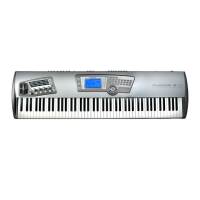4
Chapter 4: Advanced Features
224
Menu: (various modes)/Arp/Edit Arp/Playback
Parameter: Step
Value Range: 32-note triplet, Dotted 64-note, 32-note, 16-note
triplet, Dotted 32-note, 16-note, 8-note triplet, Dotted 16-note,
8-note, Quarter-note triplet, Dotted 8-note, Quarter-note,
Half-note triplet, Dotted quarter-note, Half-note, Whole-note
triplet, Dotted half-note, Whole-note, 2x whole-note triplet,
Dotted whole-note, and Double whole-note
This parameter determines the length of time that is given to each step.
Menu: (various modes)/Arp/Edit Arp/Playback
Parameter: Octave Range
Value Range: -4 to +4
This parameter spreads the notes in your arpeggiation pattern across +/-
4 octaves. This allows you to make wider-ranging arpeggiations as notes
are generated across multiple octaves.
Menu: (various modes)/Arp/Edit Arp/Playback
Parameter: Center
Value Range: On, Off
This parameter lets your arpeggiation pattern be spread to both sides of
the octave that you play. Check this box if you want your notes to be
generated both above and below the octave in which you play. Note that
is parameter only makes a difference in your pattern when your “Octave
Range” parameter is not set to “0.”
Menu: (various modes)/Arp/Edit Arp/Playback
Parameter: Note Order
Value Range: Sorted, Played, RevPlayed
The Fusion can treat your arpeggiation chords in a number of ways. The
following will break it down by type:
Sorted This setting sorts all notes you play from
lowest to highest note.
Played This setting sorts your arpeggiation pattern
exactly as you played it on the keyboard.
RevPlayed This setting sorts all of your notes in the
reverse order of what you played. In other
words, the last note you played becomes the
first note in the arpeggiation pattern.

